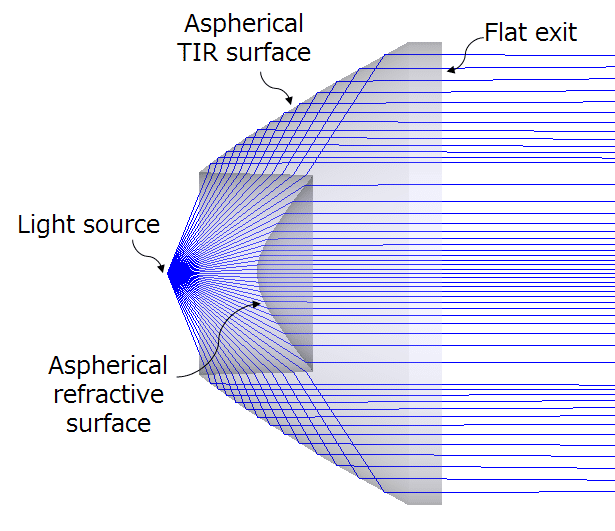This article provides the fundamentals of Nonimaging optics systems, in particular, the background and a little theory of Nonimaging optics systems.
Some background theory and concepts of Nonimaging optics design
Nonimaging optics, or non-sequential raytracing is often used for illumination optics. A different thought process is needed for most Nonimaging optics designs.
the primary goal of an Nonimaging optics design is the optimal transfer of the light source to the desired distribution on the target Nonimaging optics. However, common optical engineering properties such as color, cost, and ease of manufacture also apply. It is harder to quantify the latter requirements as a merit function

Fundamental concepts that are useful in Nonimaging optics design
Units of measure
Below is a shorthand table for quick access to the Nonimaging optics units.
| Radiometric | Photopic | ||||
| Term | Symbol | Name | Units | Name | Units |
| Flux | Φ | Power | Watts (W) | Luminous flux | lumens (lm) |
| Flux/area | E | Irradiance | W/m² | Illuminance | lm/m² or lux |
| Flux/solid angle | I | Radiant intensity | W/sr | Luminous intensity | lm/sr or candela (cd) |
| Flux/area⋅solid angle | L | Radiance | W/m²⋅sr | Luminance | lm/m²⋅sr or cd/m² or nit |
Please note that the designations of Φ, E, I, L are not universal, and sometimes P, H, J, and N are used for the corresponding radiometric quantities, while F, E, I, and B are used for the corresponding photometric quantities.
Point sources
Some light sources are small compared to the optical system, and can be reduced to a point source for more straightforward calculations.

Defining the energy
The encircled energy of a light source
In a Nonimaging optics optical system, when we eventually calculate the efficiency of the system, the encircled energy of the light source is the reference energy. Let’s take an LED as our example for encircled energy, much like the example in the image below.



Consideration of encircled energy: TIR lens

The front portion of the lens is refractive, while the side surfaces are reflective due to total internal reflection. Such a lens is a TIR lens.
Uniform distribution
One concept of Nonimaging optics design is the conservation of energy. The lens in this example distributes the Gaussian distribution of the source into a flat, top-hat distribution.

Reference Source: https://www.zemax.com/
